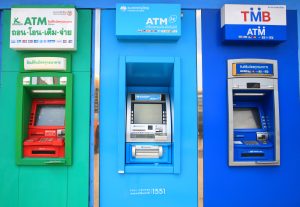In a recent post I discussed how and why Indonesian banks, both private and state-owned, have recovered strongly from the COVID-19 pandemic and are now posting large profits and paying shareholders billions of dollars in dividends. In another post, I explained how the Philippines is trying to consolidate its state-owned banks so they can be optimized for profitability and provide a source of funding for the country’s new sovereign wealth fund. But while many banks in the region have seen strong post-pandemic recoveries, Thailand’s biggest banks continue to post only modest profits.
In 2022, Bangkok Bank, Kasikornbank, and Krungthai Bank collectively held $310 billion in assets. Yet, their combined after-tax earnings were only $2.6 billion. As a point of comparison, Indonesia’s Bank Rakyat Indonesia earned more than all three Thai banks combined. None of Thailand’s three largest banks recorded more than $1 billion in net profit, and both Bangkok Bank and Kasikorn had lower earnings last year than they did in 2019. How can we explain this sluggish recovery, when other banks in the region are surging toward record profits? Why aren’t Thailand’s banks more profitable?
The first thing that jumps out is that during the pandemic, deposits at many banks around the world increased by a lot. People and businesses, unable to go about their regular activities, were forced to sit on cash. In countries like the United States, financial transfers from the government helped swell the deposit bases of many banks. But in Thailand, growth in deposits during the pandemic was relatively moderate.
At Bangkok Bank, the largest bank in Thailand by asset size, deposits grew just 17 percent from 2019 to 2022. Deposits at Indonesia’s largest non-state bank BCA jumped 47 percent during the pandemic, and at Silicon Valley Bank in the United States they exploded by 180 percent (which ultimately helped precipitate the bank’s collapse). Thailand’s big banks did not experience a similarly large rise in deposits during the pandemic, which means they had less funds available for loans and other income-generating investments.
Another thing holding back profits at Thai banks is the way their balance sheets are structured. Bangkok Bank (the bank itself, not its consolidated entities) had $110 billion in assets last year, 55 percent of which were loans to customers, 18 percent investments and 15 percent money deposited at other banks. The vast majority of interbank deposits were parked at Bank of Thailand, while the bulk of investments were in debt securities issued by the Thai government or state-owned enterprises. This is a pretty typical balance sheet for a big Thai bank. The problem, if we are talking about profits, is that money deposited at the central bank doesn’t earn a lot of interest. Bonds issues by the government and state-owned entities are also very low-yield.
I think what happened is that during the pandemic, to avoid running big deficits Thailand was somewhat restrained in the scale of its stimulus and economic rescue packages. This is supported by the fact that deposits did not increase in Thailand as much as they did in other countries where the government pumped more money into the economy.
Thailand’s financial system is also built around low interest rates. That means money held at the central bank or invested in debt securities like bonds will not earn big returns. And in Thailand, such interbank deposits and debt securities can comprise a third or more of a bank’s assets. This helps explain why Thai banks are lagging some of their regional peers in profitability.
This low-rate financial environment is by design. It is part of an economic model designed to optimize exports, surpluses and currency stability. Generally speaking, high interest rates can attract foreign capital and strengthen currencies. But Thailand doesn’t want debt-financed growth or a strong currency. They want exports. And they have designed a financial system geared toward doing that, rather than delivering big bank profits.
































